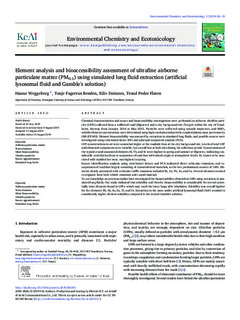| dc.description.abstract | Chemical characterization and source and bioaccessibility investigations were performed on airborne ultrafine particles (UFPs) collected from a trafficked road (Elgeseter) and a city background site (Torget) within the city of Trondheim, Norway from January 2014 to May 2015. Particles were collected using cascade impactors, and HNO3 soluble element concentrations were determined using high-resolution inductively-coupled plasma mass spectrometry (HR-ICP-MS). Element bioaccessibility was assessed by extraction in simulated lung fluids, and possible sources were investigated using enrichment factor (EF) and principal component analysis (PCA).
UFP concentrations in air were somewhat higher at the roadside than at the city background site. Levels of total UFP and elemental components were variable, but overall low at both sites during the collection period. Concentrations of the typical crustal associated elements Al, Th, and Sc were highest in spring and summer at Elgeseter, indicating considerable contribution from re-suspension of road dust with mixed origin to atmospheric levels. W, known to be associated with studded tire wear, was highest in spring.
Source identification analysis using enrichment factors and PCA indicated direct vehicular emissions, and re-suspension of road dust largely consisting of crustal-derived materials, as the two predominant sources of UFPs. Elements clearly associated with vehicular traffic emissions included Sb, Zn, Pb, As, and Cu. Several elements seemed to originate from both vehicle emissions and crustal material.
To our knowledge no previous studies have investigated the bioaccessibility of metals in UFPs using extraction in simulated lung fluids. Our study indicated that solubility and thereby bioaccessibility is considerable for several potentially toxic elements found in UFPs, which may reach the inner lungs after inhalation. Solubility was overall highest for the elements Rb, Ni, As, Sn, Tl, and Cs. Extraction in the more acidic artificial lysosomal fluid (ALF) resulted in considerably higher element solubility compared to the neutral Gamble's solution. | nb_NO |

